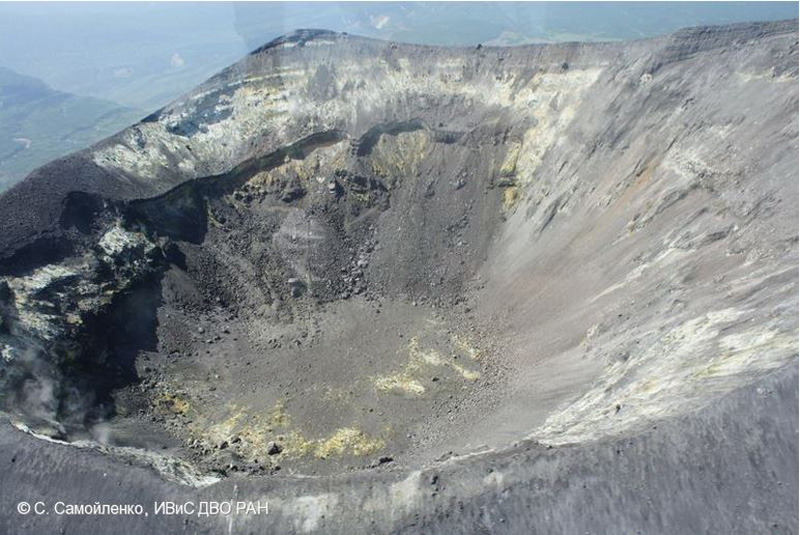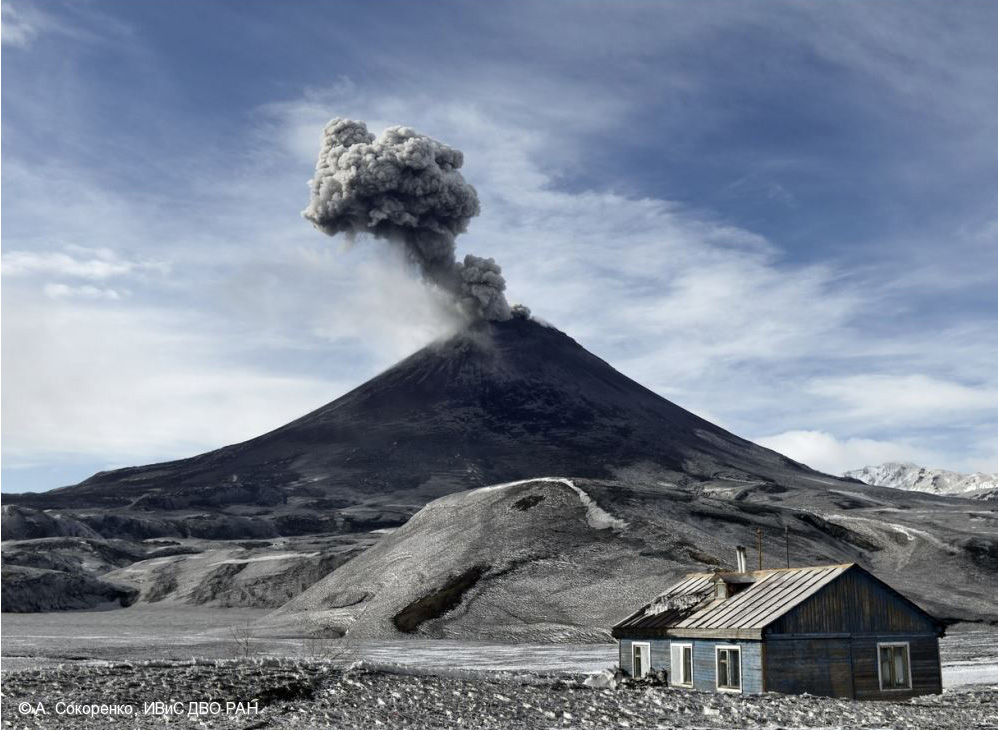Report on Karymsky (Russia) — September 2015
Bulletin of the Global Volcanism Network, vol. 40, no. 9 (September 2015)
Managing Editor: Edward Venzke.
Edited by A. Elizabeth Crafford. Research and preparation by Ken Brown.
Karymsky (Russia) Ongoing ash plumes, thermal anomalies, and seismicity through 2014
Please cite this report as:
Global Volcanism Program, 2015. Report on Karymsky (Russia) (Crafford, A.E., and Venzke, E., eds.). Bulletin of the Global Volcanism Network, 40:9. Smithsonian Institution. https://doi.org/10.5479/si.GVP.BGVN201509-300130
Karymsky
Russia
54.049°N, 159.443°E; summit elev. 1513 m
All times are local (unless otherwise noted)
During 2014 Karymsky volcano on the Kamchatka Peninsula continued its eruptive activity that had been ongoing since November 2001. Strombolian and Vulcanian activity with ash plumes as high as 4.5 km, bright thermal anomalies, and moderate seismic activity were reported by the Kamchatka Volcanic Eruption Response Team (KVERT), the Tokyo Volcanic Ash Advisory Center (VAAC) and the MODVOLC thermal alert system. The volcano was active early in the year, especially during January through April, quieted down from May through August, and then became more active again in September.
Ash plumes were reported on six different dates in January (1, 8, 18, 19, 20 and 22) (table 7), and thermal anomalies were reported on seven dates (6, 9, 18, 22, 24, 26, and 29). KVERT reported continuing moderate explosive eruptions and bright thermal anomalies all month. Moderate seismic activity was only recorded during the last week due to technical problems.
Table 7. Ash plumes reported for Karymsky during January-April 2014.
| Date | Altitude (km) | Distance (km) | Direction | Report Source |
| 01 Jan 2014 | 1.5-2 | 120 | SE | KVERT VONA |
| 08 Jan 2014 | -- | 10 | SSE | KVERT Weekly |
| 18 Jan 2014 | 2.5-3 | 40 | SSE | KVERT VONA |
| 19 Jan 2014 | 3 | -- | SSE | Tokyo VAAC |
| 20 Jan 2014 | -- | 110 | E | KVERT Weekly |
| 22 Jan 2014 | 2.0-2.5 | 60 | E | KVERT VONA |
| 22 Jan 2014 | 1.5-2 | 110 | E | KVERT VONA |
| 01 Feb 2014 | -- | 80 | E | KVERT VONA |
| 28 Feb 2014 | 1.5-2 | 55 | NE | KVERT VONA |
| 12 Mar 2014 | 1.5-2 | 40 | SW | KVERT VONA |
| 12 Mar 2014 | 1.5-2 | 75 | SW | KVERT VONA |
| 12 Mar 2014 | 1.5-2 | 70 | SE | KVERT VONA |
| 13 Mar 2014 | 1.5-2 | 230 | SE | KVERT VONA |
| 16 Mar 2014 | 2.0-2.5 | 40 | ESE | KVERT VONA |
| 16 Mar 2014 | 1.5-2 | 107 | SE | KVERT VONA |
| 17 Mar 2014 | 1.5-2 | 100 | SE | KVERT VONA |
| 17 Mar 2014 | 1.0-1.5 | 90 | SE | KVERT VONA |
| 18 Mar 2014 | 2.0-3.0 | 120 | NE | KVERT VONA |
| 20 Mar 2014 | 1.5-2 | 70 | SE | KVERT VONA |
| 21 Mar 2014 | 2 | -- | SE | Tokyo VAAC |
| 24 Mar 2014 | 2.5-3 | 180 | SE | KVERT VONA |
| 27 Mar 2014 | 2.0-2.5 | 100 | ESE | KVERT VONA |
| 28 Mar 2014 | 2 | -- | E | Tokyo VAAC |
| 31 Mar 2014 | 1.5-2.0 | 20 | SE | KVERT VONA |
| 01 Apr 2014 | 1 | 50 | SW | KVERT VONA |
| 04 Apr 2014 | -- | 100 | E | KVERT Weekly |
| 06 Apr 2014 | 2-3 | -- | -- | Tokyo VAAC |
| 12 Apr 2014 | 2-3 | -- | -- | Tokyo VAAC |
| 19 Apr 2014 | 2-3 | -- | -- | Tokyo VAAC |
In February, KVERT reported moderate seismicity indicating ongoing moderate explosive eruptive activity all month. Only two ash explosions were recorded, a small one on 1-2 February drifting 80 km E and a larger plume on 28 February rising to 1.5-2 km altitude and drifting 55 km NE. Ten MODIS thermal anomalies were recorded on six different dates (2, 12, 14, 15, 16, and 19). KVERT also indicated bright thermal anomalies visible daily during the last two weeks of the month.
Significantly more ash plume activity was recorded in March 2014, with KVERT issuing VONA (Volcano Observatory Notification to Aviation) reports on nine different dates (table 7). Late on 12 March 2014 a plume was observed with dimensions of 60 x 15 km located 70 km S of the volcano along Cape Shipunsky. MODIS thermal anomalies were recorded on 11, 16, 18, and 27 March and KVERT reported bright thermal anomalies all month. KVERT weekly reports indicated moderate seismic activity indicating continued explosive eruption activity all month.
Moderate seismic activity indicating continued explosive eruption was observed by KVERT during all of April, even though they only issued one VONA report on 1 April indicating a 1 km ash plume drifting 50 km SW. Tokyo VAAC reported additional possible plumes on 6, 12, and 19 April, drifting in different directions to heights of 2-3 km. The KVERT weekly reports indicated ash plumes were drifting about 100 km SW on 1 and 2 April (figure 31) and 100 km E on 4 April. No thermal anomalies were reported by MODIS in April, although KVERT reported a bright thermal anomaly the first week, and thermal anomalies on several other days that were not clouded over each subsequent week.
No ash plume reports were recorded from May through August, although KVERT noted moderate seismic activity in May and June. Thermal anomalies were recorded twice by MODIS, on 1 and 5 May, and were indicated by KVERT often during the first two weeks of the month and again on 25 and 27 May. MODVOLC did not record any more thermal anomalies for Karymsky in 2014. KVERT reported thermal anomalies on 11, 12, 13, and 16 June. The seismicity reported by KVERT decreased to "weak" in the second week of July (figure 32), and did not return to moderate levels until the week ending on 19 September. After mid-June, no thermal anomalies were reported until 27 August. As a result of reduced activity at the volcano in June and July, KVERT lowered the Aviation Color Code (ACC) from Orange to Yellow on 24 July.
 |
Figure 32. Aerial view of the Karymsky crater during quiet conditions on 22 July 2014. Photo by S. Samoilenko (Institute of Volcanology and Seismology FEB RAS, KVERT); courtesy of KVERT. |
A 4-km-high ash plume on 3 September extended 9 km WSW and prompted the first VONA Report from KVERT since April. Tokyo VAAC reported another ash plume on 10 September that rose to 2 km and drifted SW and then S. It was reported in the KVERT Weekly Report as extending 100 km to the SE (figure 33). Another VONA report on 15 September noted an ash plume at 3 km altitude 40 km SE of the volcano that was reported by AMC Elizovo helicopter pilots. KVERT reported weak thermal anomalies on 12 and 13 September and an ash plume drifting about 191 km E on September 28.
Another ash plume on 3 October was witnessed by AMC Elizovo helicopter pilots rising to 3 km. This corresponded to a 4-minute-long seismic event recorded by KBGS RAS (Kamchatka Branch, Geophysical Service, Russian Academy of Sciences) shortly before the observation. Tokyo VAAC reported the plume moving to the NW. KVERT also reported ash plumes on 14 (drifting 70 km E), 16 (drifting 125 km), and 20 (drifting 60 km SE) October. Tokyo VAAC reported an ash plume with the 16 October eruption rising to 3 km and drifting SE. KVERT also observed thermal anomalies on 10, 14, 16 and 20 October.
Weak and moderate seismic activity during November and a weak thermal anomaly on 29-30 November reported by KVERT indicate that the volcano did not have any major explosions that month, but another ash plume was observed by AMC Elizovo helicopter pilots on 10 December according to KVERT; the plume rose to 4.5 km altitude and drifted 30 km W.
Geological Summary. Karymsky, the most active volcano of Kamchatka's eastern volcanic zone, is a symmetrical stratovolcano constructed within a 5-km-wide caldera that formed during the early Holocene. The caldera cuts the south side of the Pleistocene Dvor volcano and is located outside the north margin of the large mid-Pleistocene Polovinka caldera, which contains the smaller Akademia Nauk and Odnoboky calderas. Most seismicity preceding Karymsky eruptions originated beneath Akademia Nauk caldera, located immediately south. The caldera enclosing Karymsky formed about 7600-7700 radiocarbon years ago; construction of the stratovolcano began about 2000 years later. The latest eruptive period began about 500 years ago, following a 2300-year quiescence. Much of the cone is mantled by lava flows less than 200 years old. Historical eruptions have been vulcanian or vulcanian-strombolian with moderate explosive activity and occasional lava flows from the summit crater.
Information Contacts: Kamchatka Volcanic Eruptions Response Team (KVERT), Far East Division, Russian Academy of Sciences, 9 Piip Blvd., Petropavlovsk-Kamchatsky, 683006, Russia (URL: http://www.kscnet.ru/ivs/); Tokyo Volcanic Ash Advisory Center (VAAC), Tokyo, Japan (URL: http://ds.data.jma.go.jp/svd/vaac/data/); Hawai'i Institute of Geophysics and Planetology (HIGP), MODVOLC Thermal Alerts System, School of Ocean and Earth Science and Technology (SOEST), Univ. of Hawai'i, 2525 Correa Road, Honolulu, HI 96822, USA (URL: http://modis.higp.hawaii.edu/)



